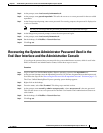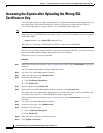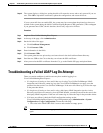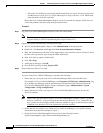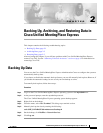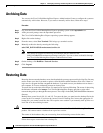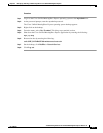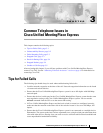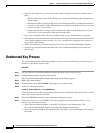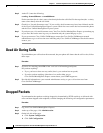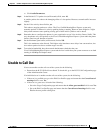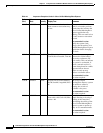
CHAPTER
3-1
Troubleshooting Guide for Cisco Unified MeetingPlace Express Release 1.2
OL-11303-01
3
Common Telephone Issues in
Cisco Unified MeetingPlace Express
This chapter contains the following topics:
• Tips for Failed Calls, page 3-1
• Undetected Key Presses, page 3-2
• Failed Incoming Calls, page 3-3
• Dropped Calls, page 3-3
• Dead Air During Calls, page 3-4
• Dropped Packets, page 3-4
• Unable to Call Out, page 3-5
After reviewing this chapter, if you still have problems with Cisco Unified MeetingPlace Express,
contact Cisco TAC. See the “Obtaining Technical Assistance” section on page vi for information on
contacting Cisco TAC.
Tips for Failed Calls
The following tips should always be used when troubleshooting failed calls:
• Look for network congestion at the time of the call. Network congestion information can be found
via router and switch statistics.
• Ensure that the Cisco Unified MeetingPlace Express system is set to full-duplex with 100 Mbps
network speed.
• Ensure that the local switch port for the Cisco Unified MeetingPlace Express system has the same
auto-negotiation setting as the Cisco Unified MeetingPlace Express system. You can run the
mii-tool command from the CLI to see the current link setting.
• If Cisco Unified MeetingPlace Express and the local switch (or router) are configured correctly,
make sure that the network on the other side of the switch or router is also set to 100 Mbps, full
duplex.
• Ensure that the Cisco Unified MeetingPlace Express system is not connected to a multiple-device
Ethernet bus. The system works best if micro-segmented to use a single switch port rather than share
a bus with other devices. Sharing a bus can cause excessive collisions which reduce bandwidth and
cause unpredictable bandwidth availability.



